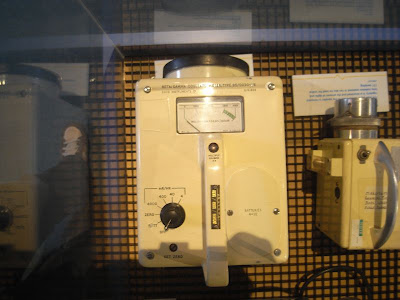
 The one above is my favourite - the big sphere is actually part of the instrument. This is a neutron meter, used to measure the number of neutrons around a reactor or a plutonium store. It was used from the late 60's to the late 70's...
The one above is my favourite - the big sphere is actually part of the instrument. This is a neutron meter, used to measure the number of neutrons around a reactor or a plutonium store. It was used from the late 60's to the late 70's... This one above is a vintage beta and gamma dose rate meter from the seventies. Used to measure radiation dose rate in the field or at the workplace.
This one above is a vintage beta and gamma dose rate meter from the seventies. Used to measure radiation dose rate in the field or at the workplace. This is a more interesting one. The one in the middle is a portable air sampler, from the late 60's. The filter paper on the front was removed regularly. It was examined for alpha, beta radiaton and assessed later. Could be used for Iodine 131 monitoring as well.
This is a more interesting one. The one in the middle is a portable air sampler, from the late 60's. The filter paper on the front was removed regularly. It was examined for alpha, beta radiaton and assessed later. Could be used for Iodine 131 monitoring as well. Here we go onto the more exotic fast neutron meter. This early 60's instrument was used around a nuclear reactor.
Here we go onto the more exotic fast neutron meter. This early 60's instrument was used around a nuclear reactor. This one above is just a regular gamma dose rate meter from the 70's.
This one above is just a regular gamma dose rate meter from the 70's. And a background radiation monitor, used around nuclear waste in the 70's. It has its readings in counts per second: CPM. I like the cool "gun shaped" design. I wonder wheter it is meant to give readings from a distance...
And a background radiation monitor, used around nuclear waste in the 70's. It has its readings in counts per second: CPM. I like the cool "gun shaped" design. I wonder wheter it is meant to give readings from a distance... Here we go onto some film badges. Were worn by workers in the nuclear industry, have been largely replaced by digital, reusable equivalents. The films became more darker as they gathered radiation - this way the dose could be estimated. The one on the right (blue) is actually sensitive to slow neutrons too!
Here we go onto some film badges. Were worn by workers in the nuclear industry, have been largely replaced by digital, reusable equivalents. The films became more darker as they gathered radiation - this way the dose could be estimated. The one on the right (blue) is actually sensitive to slow neutrons too!That's all, hope you enjoyed our little tour to "retro" equipment - sorry for the bad quality photos. It was really dark in the whole museum, and this exhibition was no exception...





0 comments:
Post a Comment